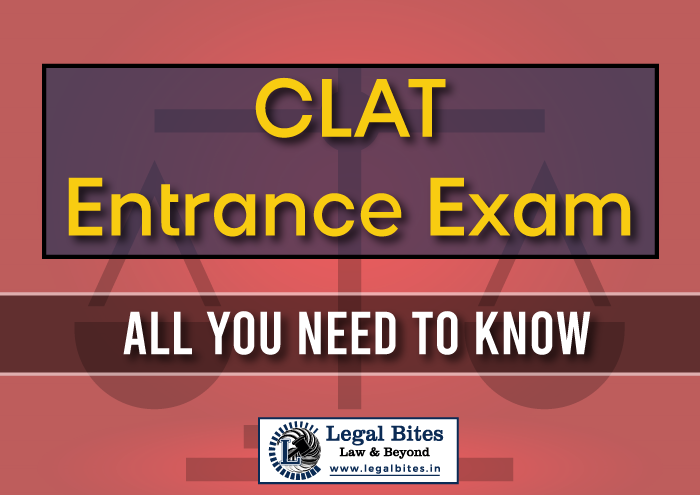CLAT Entrance Exam | Eligibility, Exam Pattern – All you need to know
CLAT Entrance Exam | Overview About CLAT Entrance Exam Duration Eligibility for CLAT Entrance Exam Marking Scheme for CLAT Entrance Exam Examination Fee How to Apply Exam Pattern This article provides complete information about CLAT Entrance Exam. It deals with Eligibility, Marking Scheme and Exam Pattern in detail. Subscribe to Legal Bites and Stay Updated. About CLAT Entrance… Read More »

CLAT Entrance Exam | Overview
- About CLAT Entrance Exam
- Duration
- Eligibility for CLAT Entrance Exam
- Marking Scheme for CLAT Entrance Exam
- Examination Fee
- How to Apply
- Exam Pattern
This article provides complete information about CLAT Entrance Exam. It deals with Eligibility, Marking Scheme and Exam Pattern in detail. Subscribe to Legal Bites and Stay Updated.
About CLAT Entrance Exam
The common law aptitude test (CLAT) is an entrance level examination for aspiring law students who are thriving to get into the top 22 national law universities (NLU’s) of India. A competitive exam that not only examines the legal aptitude of a student but also focuses upon the mental and logical ability.
With around 60,000 students applying every year, only 2800 of them make their way to these prestigious and reputed law colleges of India.
Those who undertake this examination are applying for a BA L.LB., BBA L.LB. (5 years) integrated course with an aim to receive an optimum level of placement after completing their course. The abundance of students opting for the law as a career has eventually increased the number of applicants, thus, paving a way for a more difficult examination.
I. Duration
The examination is 2 hours long (120 minutes) and contains 150 multiple-choice questions. CLAT 2023 exam is scheduled for December 18, 2022.
II. Eligibility for CLAT Entrance Exam
The students who have secured a minimum of 45% in their 10+2 board examination under the general /OBC/ Specially abled categories are eligible to appear for the examination. Whereas, those belonging to scheduled castes/ scheduled tribes at least require 40% in their 10+2 examination
III. Marking Scheme for CLAT Entrance Exam
Every correct answer in the examination rewards a 1 mark to the student, but an incorrect answer leads to a deduction of 0.25 marks.
IV. Examination Fee
The examination fee for general category/ OBC/ PWD/ NRI is 4000 rupees and for Scheduled castes/ Scheduled tribes is 3500 rupees.
V. How to Apply
VI. Exam Pattern
The common law aptitude test is divided into 5 sections,
- Legal Reasoning.
- Logical Reasoning.
- Quantitative Techniques.
- Current Affairs, including General Knowledge.
- English Language.
Legal Reasoning
In order to examine the general understandings and principles of the legal sphere, the CLAT consortium has introduced this section. This section mainly includes the study of basic law concepts like Law of Torts, Law of Contracts, Criminal law, legal maxims, constitutional law, important Supreme court judgments etc.
35-39 questions or roughly 25% of the paper are asked from legal reasoning. Therefore, a focused and detailed study can help a student fetch marks easily and act as a plus point for the applicants.
General Knowledge and Current affairs
This section can turn out to be a nightmare for some but for those who can inculcate the habit of reading the newspaper every day and being updated about the current happenings in the world can easily beat other applicants during the examination.
All you need to do is ‘READ, READ AND READ’.
It covers all the spheres of news like Contemporary events of significance from India and the world, International affairs, Historical events of continuing significance, Arts and culture. The total number of questions that appear is 35-39
Quantitative Techniques
Mathematics is considered a daunting subject for most of us, but basic mathematical skills are required in day to day life to solve problems logically and re-think solutions.
This section will include short sets of facts or propositions, graphs, or other textual, pictorial or diagrammatic representations of numerical information, followed by a series of questions. You will be required to derive information from such passages, graphs, or other representations, and apply mathematical operations on such information. The total number of questions that appear is 13-17.
English Language Comprehension
Any field whether it is business or law requires a basic knowledge of English. This section mainly includes reading comprehensions, basic grammar, error detection, synonyms, antonyms etc.
The comprehension question is based on analyzing and deriving the current solution without any requirement of prior knowledge. The total number of questions that appear is 28-32.
Each passage will be followed by a series of questions that will require you to demonstrate your comprehension and language skills, including your abilities to:
- Read and comprehend the main point discussed in the passage, as well as any arguments and viewpoints discussed or set out in the passage;
- Draw inferences and conclusions based on the passage;
- Summarise the passage;
- Compare and contrast the different arguments or viewpoints set out in the passage; and
- Understand the meaning of various words and phrases used in the passage
Logical Reasoning
The Logical Reasoning section will include a series of short passages of about 300 words each. The total number of questions that appear is 28-32.
Each passage will be followed by one or more questions that will require you to:
- Recognize an argument, its premises and conclusions;
- Read and identify the arguments set out in the passage;
- Critically analyse patterns of reasoning, and assess how conclusions may depend on particular premises or evidence;
- Infer what follows from the passage and apply these inferences to new situations;
- Draw relationships and analogies, identify contradictions and equivalence and assess the effectiveness of arguments.


